Betta Hendra Care Guide: Blackwater Aquarium Setup & Habitat
By Fernando Granadino (@MirkwoodBettas)
In the shadowy peat swamps of Borneo, beneath a dense canopy where sunlight barely breaks through, lives a fish so rare and delicate that few ever encounter it in the wild: the Betta hendra. Found only in small, isolated pockets of blackwater pools, this species thrives in a mysterious world of tannin-stained waters, tangled roots, and decaying leaf litter. Critically endangered and facing rapid habitat loss, Betta hendra are not just another aquarium fish; they are a fragment of a declining ecosystem.
This guide aims to provide a thorough understanding of the Betta hendra, covering everything from their social behavior and tank requirements to breeding and how we can contribute to the preservation of a species on the brink of extinction.
A male Betta Hendra Flares in Display with another Male
Introduction to Betta Hendra (Betta coccina complex)
The Betta hendra is a member of the Betta coccina complex (group) and is known for the iridescent blue-green coloration in males, the subtle beauty of females, and the fascinating behavior of the species. Unlike the more commonly kept Betta splendens, Betta hendra are smaller (2 to 3 inches / 5 to 7 centimeters, with males being slightly larger on average), generally more peaceful, and require specialized conditions to thrive. Their natural blackwater habitats are delicate and complex, making it essential for aquarists to replicate these conditions as closely as possible in captivity. More on that later in this guide.
A male Betta Hendra swims through a cluster of Alder Cones.
Betta Hendra Temperament and Social Behavior
As mentioned previously, Betta hendra belong to the Coccina complex, and species in this complex are generally less aggressive than other groups of bettas, such as splendens or imbellis. Other species in the Coccina complex include Betta mulyadii, Betta iaspis, and Betta persephone.
Unlike their splendens cousins, the actual “Siamese fighting fish”, these remarkable little fish are more akin to a performance than an actual fight. They will engage in elaborate “dance-offs”; swimming displays, where they flaunt their fins and bright coloration to assert dominance. This behavior is crucial to establishing hierarchy and territorial boundaries without resorting to violence. In fact, serious physical confrontations are a last resort among these fish. However, they are bettas after all, so some territory disputes will involve sparring and end with a torn fin or a missing scale.
A well-structured ecosystem and careful monitoring are vital to preventing over-aggression and ensuring a harmonious tank.
Can Betta Hendra Be Kept Together in a Community Tank?
Hendra are indeed social bettas; however, this doesn’t mean they can be housed together without any consideration. While less prone to aggression, territorial disputes will still happen as mentioned above, especially in confined spaces or if there are insufficient hiding spots.
To successfully house Hendra together, a tank of around 10 gallons (37 liters) is recommended for a single pair, complemented with plenty of vegetation, hiding spots, botanicals and/or visual barriers. For a colony of around 10 fish, 20 gallons (75 liters) would be the minimum. Regular monitoring of their interactions is crucial, particularly during the initial introduction period, when territories are yet to be claimed and hierarchies have not been determined.
Note from the Author: In my experience caring for Betta hendra, I observed a unique “sorority-like” behavior where overall aggression significantly declined once the colony reached a number of over 20 individuals. However, this occurred in a highly controlled, carefully balanced environment with ample space, heavy planting, and stable water conditions. It should not be viewed as a goal for most hobbyists, as attempting this without proper preparation can lead to stress or harm.
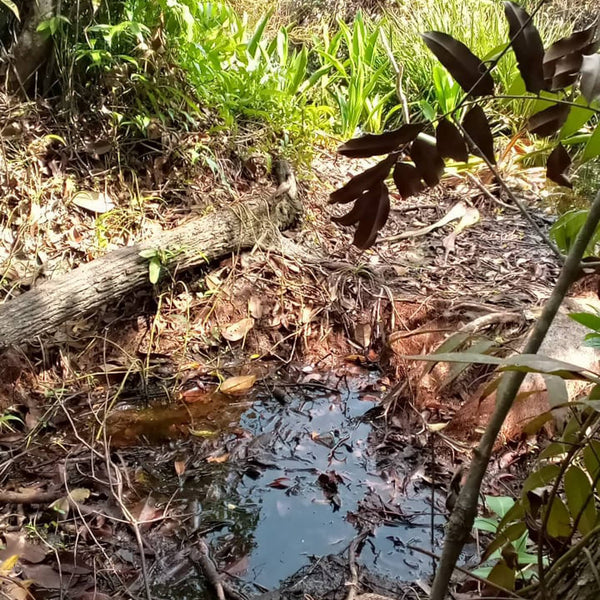
A seasonally flooded pool where Betta Hendra can be found.
Building a Betta Hendra Blackwater Aquarium
Recreating an ecosystem that mirrors the natural environment of the Betta hendra is essential for their health, comfort, and overall well-being. Below, I’ll break down the key components of designing the perfect habitat for these fish.
Tank Size and Layout for Betta Hendra Aquariums
Although Betta hendra are a smaller betta species, they are active swimmers that appreciate room to explore. A minimum tank size of 20 gallons (75 liters) is recommended, especially if you plan on keeping a small colony. Design the layout with plenty of cover and hiding spots using live plants, rocks, botanicals, and driftwood. This creates a safe, natural feel and adds to the visual beauty of your aquarium.
Tip: Betta Hendra dislike open, exposed spaces, which make them feel vulnerable and make them want to hide all the time. Lowering the water level or adding floating plants for cover provides security and encourages natural behaviors.
A vernal pool where Betta Hendra can be found.
Substrate and Water Conditions in Botanical Method Aquariums
Your substrate forms the foundation of the ecosystem, so choose wisely. A dark-colored substrate helps replicate their natural blackwater environment and enhances their coloration. To deepen the blackwater effect, add leaf litter and botanicals such as Macaranga leaves, Terentang leaves, or sterculia pods. These naturally release tannins, creating a tea-colored tint that makes Betta hendra feel at home. Many of these botanicals also have anti-bacterial properties, promoting healthier water conditions.
Tip: Try to recreate the Betta hendra’s habitat as closely as you can. A substrate made up of a mix of peat and fine sand is a fantastic option. Additionally, adding botanicals endemic to Southeast Asia, such as Climbing Swamp Ferns, Swamp Grass, Catappa Bark (and leaves), and Jambolan Leaves, is a great way to build a “biotope-inspired” tank for your bettas.
In the Botanical Method Aquarium, substrate is a living engine of your ecosystem. As leaves and pods slowly break down, they enrich the substrate with detritus, fungi, and biofilms. This ‘perpetual substrate’ supports microfauna that, in turn, provide supplemental food for the fry and adult Betta hendra. Rather than being siphoned away, these natural layers mirror the forest floor, fueling the microbial cycles that stabilize your aquarium long-term.
Maintain soft, acidic water with a pH ideally between 4.0 and 6.0, hardness below 5 dGH, and temperatures of 75 to 82°F (24 to 28°C). Using reverse osmosis (RO) water or rainwater helps achieve these conditions, but always re-mineralize to maintain essential nutrients. If RO or rainwater isn’t available, you can lower pH naturally with botanicals like alder cones and macaranga leaves.
Note from the Author: I observed that newly hatched larvae and fry had extremely low survivability at pH 6.8 or higher. The few survivors were significantly smaller than their contemporaries of the same age. At pH 7 and above, adults exhibited consistent horizontal stress lines and extremely pale coloration. It’s important to note that these pH conditions were not intentionally created; they were a result of river sand that drastically altered pH.
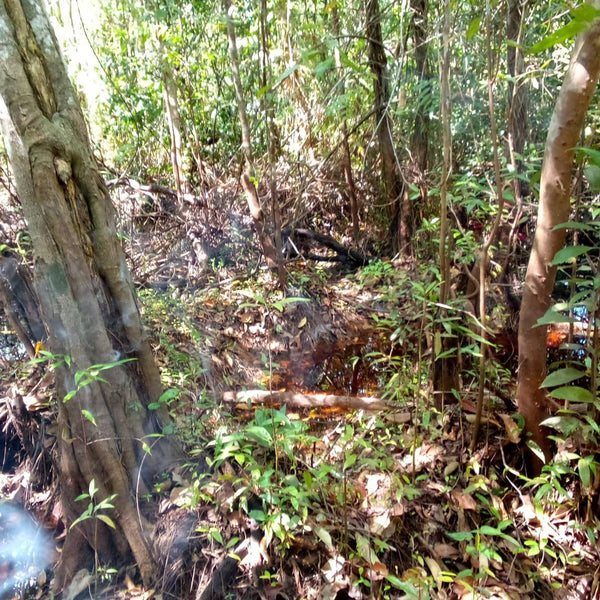
A summer time vernal pool with Betta Hendra.
Filtration and Water Movement in Blackwater Tanks
Betta hendra inhabit slow-moving or still bodies of water, so choose a filtration system that provides excellent biological filtration without generating strong currents. Sponge filters are an excellent choice, especially if you plan to breed them, as they’re gentle on fry. Alternatively, hang-on back, internal, or canister filters work well as long as the flow is carefully regulated to maintain calm conditions.
It is important to note that the hardscape, substrate, and botanicals you add to your tank will all provide a lot of surface area for beneficial bacteria to colonize and aid with the biological filtration. This principle is at the heart of the Botanical Method Aquarium. Instead of relying heavily on external filters, the surface area provided by leaves, bark, and seed pods becomes the true filter of the system. Biofilms and microbial colonies flourish on these materials, consuming waste and stabilizing water chemistry for your Hendra. Your aquarium itself functions as a biological filter, with botanicals serving as both structure and fuel for these vital microbial populations.
Lighting and Vegetation for Betta Hendra Habitats
Betta hendra thrive under low to moderate lighting, mimicking the dim, tea-stained waters of their native peat swamps. Keep in mind, however, that many plants struggle in such subdued conditions.
For best results, choose hardy species that tolerate low-light and acidic environments. Here are a few options:
- Floating plants like Red Root Floaters, Salvinia cucullata, or Salvinia oblongifolia will love being close to the light, but will also create shaded areas that provide natural cover.
- Rooted plants like Cryptocoryne offer excellent shelter and stability to the substrate.
- Epiphytes such as Java Ferns and Bucephalandra thrive when attached to driftwood or rocks and are ideal for low-light setups.
Feeding Betta Hendra: Diet, Live Foods, and Microfauna
Betta hendra are carnivorous fish and require a protein-rich diet. In the wild, their diet consists of small insects, larvae, and other protein-rich delicacies they can find amongst the leaf litter. The best thing you can do is offer them a varied diet; a mix of high-quality micro pellets, flakes, freeze-dried foods, frozen foods like brine shrimp and daphnia, as well as live foods whenever possible.
Live foods should always be your “Go-To” and are without a doubt the best option for them; they not only provide essential nutrients, but also stimulate their natural hunting instincts, contributing to their physical and mental well-being. Vinegar eels, grindal worms, baby brine shrimp, brine shrimp, and mosquito larvae are all fantastic options. Aquarists who embrace the Botanical Method will notice that Betta hendra often graze directly on leaf litter and botanicals, picking at biofilms, fungi, and tiny organisms living there. This steady supply of ‘supplemental nutrition’ mirrors their wild feeding strategy and helps keep them resilient between meals. By letting botanicals break down at their own pace, you’re cultivating a ‘living pantry’ of sorts inside the aquarium.
Tip: Condition your Betta hendra to eat high-quality pellets. This will allow you to use automatic feeders when you go out of town.
Breeding Betta Hendra in a Blackwater Aquarium
Breeding Betta hendra is a fascinating process that showcases the unique behaviors and instincts of the betta complex they belong. Unlike domestic bettas, their courtship is more subtle and relies on environmental cues, making it essential to closely replicate their natural conditions for the highest rate of success.
Courtship and Spawning Behavior of Betta Hendra
In the wild, hendra inhabit shaded pools where soft lighting and abundant cover trigger natural breeding behaviors. When conditions are ideal, the male begins courting the female through color displays and gentle movements. His colors intensify, shimmering in iridescent blues and greens, but now show vertical brown stripes, and he will flare his fins to appear larger and stronger; worthy to pass on his genes. This dance is identical to territorial displays, but for one subtle difference; the male twitches a few times mid dance.
The female, if receptive, will respond with similar displays of vertical stripes and approach the male cautiously. Courtship often involves a delicate dance: circling one another beneath floating leaves or botanicals, where the male encourages the female to move closer to his chosen spawning site.
Tip: To encourage breeding in your wild bettas, feed them exclusively live foods for a day or two. Then, perform a larger-than-usual water change. This combination of abundant food and cooler water simulates the rainy season in the wild, which is when their offspring have a higher chance of survival.
A male Hendra guards a singular egg in our breeding tube.
Bubble Nest Building and Egg Care in Betta Hendra
As part of the breeding ritual, the male constructs a bubble nest; a cluster of tiny air bubbles coated in saliva that is usually built beneath floating plants or floating botanicals. This nest serves as a safe haven for the eggs and developing fry.
Once the nest is complete, the male lures the female beneath it. During spawning, the male wraps his body around the female in an embrace, and with each embrace, the female releases a small batch of eggs that the male instantly fertilizes. After fertilization, the male carefully collects the eggs in his mouth and places them into the bubble nest. This process continues until the female has released all her eggs. In most cases, spawning lasts a few hours and results in 10 to 20 eggs.
Male Parental Care in Betta Hendra Breeding
After spawning, the female typically retreats, and from this point forward, the male assumes full parental duties, guarding the nest and tending to the eggs meticulously. The male will guard the eggs within the bubble nest, repairing it if bubbles collapse and gently fanning the eggs to keep them oxygenated until they hatch, typically within 24 to 48 hours.
Tip: After the female retreats, make sure there is plenty of room in the tank for her to live as far away as possible from the nest. The male will viciously protect the nest against anything that comes near it. I recommend adding visual barriers around the nest so the male can’t see much of his surroundings.
Early Stages: Raising Betta Hendra Fry
Once hatched, the fry remain attached to the nest as larvae, absorbing their yolk sacs for nourishment. During this stage, they are extremely fragile and should not be fed yet. The male continues to guard them closely, retrieving any fry that fall from the nest and returning them to the safety of the bubble nest.
Tip: To increase your chances of a successful spawn, consider introducing a breeding tube. This simple plastic piece will maintain the bubble nest and its precious cargo safe, help maintain humidity, and prevent the eggs or larvae/fry from falling and becoming snacks for other tank mates before the male can retrieve them.
After 3 to 5 days, the fry become free-swimming and begin exploring their environment. At this stage, the male abandons the nest, and the new generation of hendra babies is left to fend for themselves.
Taking Care of Betta Hendra Fry in Blackwater Aquariums
Feeding the Fry: Infusoria, Baby Brine, and Microworms
During the first few days, the fry survive on their yolk sacs and do not require feeding. Once they are free-swimming, start with infusoria or other microscopic foods to match their tiny mouths. After about a week, gradually introduce live baby brine shrimp and microworms, such as vinegar eels, to support their rapid growth.
Tip: Offer small, frequent meals rather than large portions to avoid polluting the water.
Water Quality and Stability for Betta Hendra Fry
Fry are extremely sensitive to changes in water quality. Perform gentle, frequent water changes (about 10 to 15% daily) using aged, conditioned water that matches their current parameters. Be very gentle with these water changes, as the fry can easily get hurt.
Environment and Growth of Betta Hendra Fry
To ensure the fry’s proper development of the labyrinth organ, maintain high humidity by keeping the tank covered. Dim lighting helps reduce stress, while leaf litter and botanicals provide shelter and infusoria for natural grazing.
As the fry grow, gradually introduce slightly larger foods and maintain stable parameters to support healthy color and fin development. With careful feeding, stable water conditions, and a calm environment, Betta hendra fry grow steadily and begin displaying their characteristic iridescent blues and greens within the first 5 to 6 months. This is where patience—one of the core principles of the Botanical Method—pays off. Rather than trying to sterilize the nursery, allowing botanicals to break down naturally allows infusoria and microbial blooms that fry depend on in their earliest days. By resisting the urge to over-clean, you give fry access to the same ecological safety net they’d rely on in the wild: a food web fueled by leaves and detritus.
Note from the Author: While it’s possible to have a small and controlled environment like a grow-out tank, it’s not feasible to make one out of a large 40-gallon community tank. Unless you meticulously control spawning within your colony, keeping track and caring for every single batch of fry will be extremely challenging. Once you establish the ideal ecosystem for them, they will naturally breed. Some fry will even survive without the target feeding and daily water changes, just like in their natural habitat, “Life finds a way”. Congratulations on creating a perfect ecosystem for them!
Betta Hendra Conservation: On the Brink of Extinction
The Betta hendra is a living fragment of a rapidly vanishing ecosystem. Found only in the fragile peat swamp forests of Central Kalimantan, Borneo, this species now faces a critical risk of extinction as its natural habitat disappears at an alarming rate. Hendra are listed as critically endangered by the International Union for Conservation of Nature (IUCN), which means they are facing an extremely high risk of going extinct in the wild.
Causes of Betta Hendra Population Decline
Betta hendra’s limited distribution to this one region makes them highly vulnerable to environmental changes. The main threats include:
- Deforestation and Habitat Loss: Vast areas of Borneo’s peat swamp forests are being cleared for palm oil plantations and other agricultural developments. This destruction eliminates the shaded, tannin-rich waterways where Betta hendra live.
- Peatland Drainage: Peat swamps are often drained for farming, lowering water levels and changing water chemistry beyond what the species can tolerate.
- Pollution: Runoff from agricultural chemicals, mining, and human waste contaminates these delicate ecosystems.
- Climate Change: Shifts in rainfall patterns and prolonged droughts further threaten their limited habitat.
- Overcollection: While less significant than habitat loss, unsustainable collection for the aquarium trade has historically contributed to population decline.
How Aquarists Can Help Conserve Betta Hendra
As aquarists, we play a crucial role in protecting not only this beautiful little fish, but also thousands of threatened species, both in captivity and in the wild.
- Choose Captive-Bred Fish: Always source fish from responsible breeders rather than wild-caught specimens. Supporting captive-bred populations reduces pressure on wild stocks and encourages sustainable practices.
- Participate in Conservation Breeding: If you have the knowledge and resources, consider contributing to captive breeding programs. Sharing fry with other hobbyists helps strengthen the genetic pool and ensures availability without harming natural populations.
- Support Habitat Conservation: Many organizations work to protect and restore Borneo’s peat swamps. Donating, volunteering, or raising awareness can directly impact conservation efforts on the ground.
- Educate the Community: Use your voice in the aquarium hobby to spread awareness about Betta hendra and other species' endangered status. Encourage responsible sourcing, ethical care, and habitat preservation.
- Recreate Their Ecosystem: Keeping fish in biotope-inspired setups not only benefits the fish but also educates hobbyists about the delicate ecosystems they come from, which fosters a deeper connection and respect for their natural habitats.
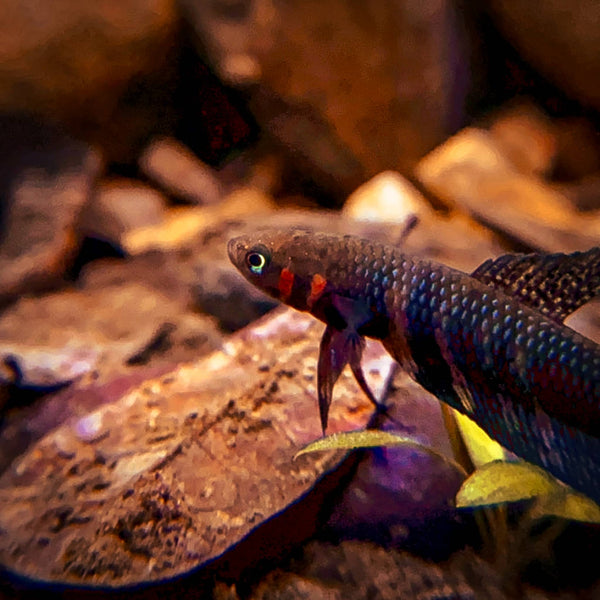
A male Betta Hendra above a leaf litter bed.
Becoming a Steward for Betta Hendra
Embracing the role of a Hendra keeper goes beyond the typical fish care; it’s a journey into preserving a piece of the natural world within your living space. Betta hendra, with their mesmerizing colors and graceful movements, are more than just aquarium inhabitants; they are ambassadors of the fragile ecosystems of Borneo, reminding us of the delicate balance of life that demands our attention and care.
By creating an ideal habitat, offering a balanced diet, and understanding their unique behavioral traits, you lay the groundwork for your wild bettas to thrive. Your commitment to sustainable practices and support for conservation not only aids in the survival of this critically endangered species but also contributes to the broader efforts of preserving biodiversity and aquatic habitats worldwide.
Engage with the aquarist community, share knowledge, and continuously learn. By responsibly setting up every tank and diligently caring for every fish, you become a beacon of hope, showcasing the remarkable achievements of passionate and informed fishkeeping. Remember, every action counts in the quest to protect and preserve these stunning creatures. Every Betta hendra kept with love and respect contributes to a future where these magnificent beings thrive not only in our homes but also in the wild.
I learned that to keep Betta hendra is to preserve a fragment of a vanishing world; a living story written in tannin-stained waters and fragile ecosystems. These fish carry within them the memory of Borneo’s disappearing swamps, a reminder of everything that’s at risk beyond the glass. Their survival depends on more than the forests they come from; it depends on us, on the choices we make, the care we give, and the respect we show for the wild they represent.
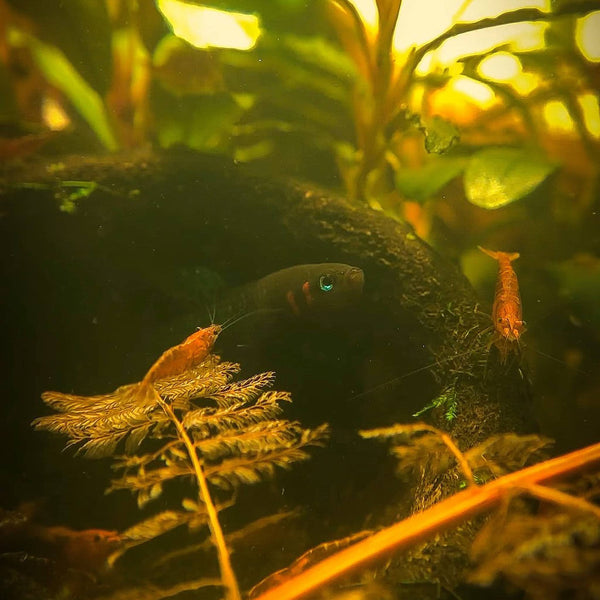
A male Hendra inside a Sterculia Pod with Cherry Shrimp.
List of Organizations that Support Betta Hendra Conservation
The following organizations support the conservation of Betta hendra either directly, or indirectly through the protection of their natural habitat in Borneo, or other Peat Swamps across the Globe.
- Borneo Nature Foundation (BNF)- https://www.borneonaturefoundation.org
- Asian Species Action Partnership (ASAP)- https://www.speciesonthebrink.org
- The Borneo Project- https://borneoproject.org/biodiversity-conservation/
- Shoal- https://shoalconservation.org
About The Author
Fernando is a member of our #Tanninbae ambassador program, specializing in Betta Hendra care and stewardship. He has been keeping fish for years, but stepped to the tinted side of the hobby about 2 years ago. His favorite botanicals are Sterculia Pods and Betta Tea.





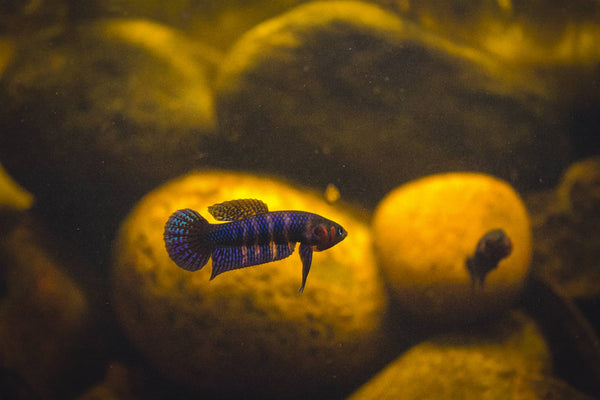
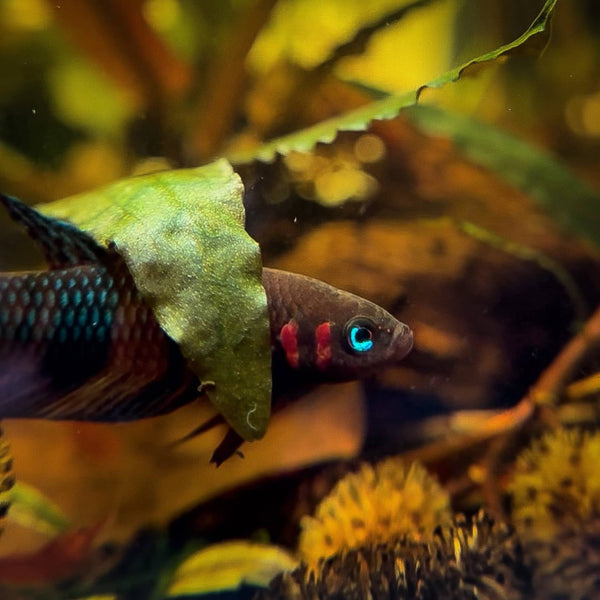
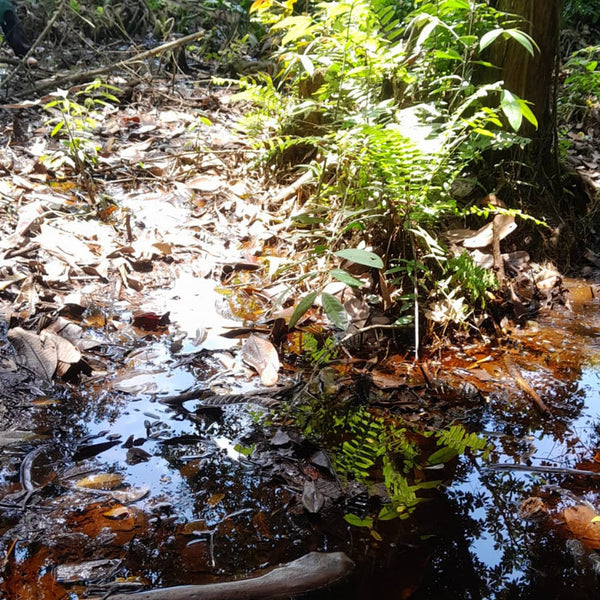
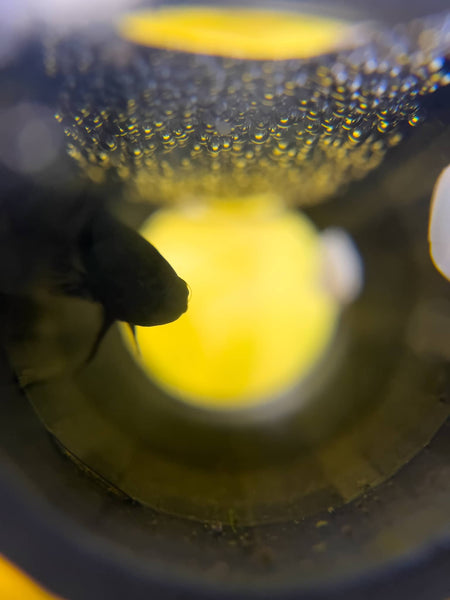




Inspire your friends:
Getting Dirty, A Guide to Creating a Dirted Botanical Method Aquarium
2 comments
I keep coming back to this article because I’m so excited about getting my tank ready for hendras. I’ve fallen head over heals for them and someday when I have more a lot more space and time I would love to set up a responsible breeding operation to help keep them alive and to let more people appreciate how beautiful they are.
Fantastic and highly informative article. I recently “discovered” this species while reading The Betta Bible, where there was a photo. I immediately fell in love with its look.